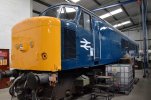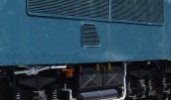-
Our new ticketing site is now live! Using either this or the original site (both powered by TrainSplit) helps support the running of the forum with every ticket purchase! Find out more and ask any questions/give us feedback in this thread!
You are using an out of date browser. It may not display this or other websites correctly.
You should upgrade or use an alternative browser.
You should upgrade or use an alternative browser.
What class of 'Peak' is this?
- Thread starter Simon E
- Start date
- Status
- Not open for further replies.
Sponsor Post - registered members do not see these adverts; click here to register, or click here to log in
R
RailUK Forums
43096
On Moderation
- Joined
- 23 Nov 2015
- Messages
- 16,994
Class 45/1. The ETH jumper on the buffer beam gives it away.
delt1c
Established Member
- Joined
- 4 Apr 2008
- Messages
- 2,155
45
Simon E
Member
Thank you
Thank you that's what I thought it was but didn't take any notes when i took the photo!
VicH
Member
I believe you can't tell them apart
hexagon789
Veteran Member
The ETH connector basically confirms it as a 45/1.
If that wasn't present, there are two ways of telling 45s apart from 46s, but where they would be are not visible in that photo!
If that wasn't present, there are two ways of telling 45s apart from 46s, but where they would be are not visible in that photo!
The headlight between the marker lights also confirms it is one of the locos which lasted later in service (fitted around 1986 I believe) and the last of the surviving locos was withdrawn in 1988.
Not sure which of the preserved locos retain this feature but from memory 132 and 133 retain them.
Not sure which of the preserved locos retain this feature but from memory 132 and 133 retain them.
Elecman
Established Member
Class 45
Intercity110
On Moderation
What’s the difference between the different classes of peak?
Simon E
Member
Thanks again for all the answers. the photo was taken last summer at The Midland Railway Centre
That makes it 45133Thanks again for all the answers. the photo was taken last summer at The Midland Railway Centre

Skymonster
Established Member
- Joined
- 7 Feb 2012
- Messages
- 1,996
45133
Kneedown
Established Member
Not too sure about 44's apart from disc headcodes and driving controls.What’s the difference between the different classes of peak?
The main difference between 45s and 46s is Crompton Parkinson electrics on the 45, and Brush electrics on the 46.
45s also had big brass power handle and reverser, along with a visible "X" form on the fuel tank. A 46 had similar controls to a 47, and a plain sided fuel tank.
2392
Member
The main differance between the class 44 and 45 being the type of engine used. With differences between the 45's and 46's being the electrical equipment [i.e. traction motors and the like], otherwise they had the same engines.What’s the difference between the different classes of peak?
Simon E
Member
Thanks for kneedown and 2392 for the posts on the differences between the two. I figured this was photo was 45133 from previous internet searches but had another peak class photo (44 ?) from the same day so wanted to be sure
2392
Member
The 44's were part of the modernization plan I believe an shared the same style body. There are two survivors from memory one being Penyghent and there were IIRC only 10 built all named after various "peaks" hence the generic name of the three classes....
12LDA28C
Established Member
- Joined
- 14 Oct 2022
- Messages
- 5,058
Thanks for kneedown and 2392 for the posts on the differences between the two. I figured this was photo was 45133 from previous internet searches but had another peak class photo (44 ?) from the same day so wanted to be sure
A 44 looks very different from a 45, apart from 44009 which had a central headcode panel at one end in later life.
Not too sure about 44's apart from disc headcodes and driving controls.
12LDA28A engine rather than 12LDA28B, 2300bhp rather than 2500.
70014IronDuke
Established Member
- Joined
- 13 Jun 2015
- Messages
- 3,892
Perfectly true - but you can't see that unless you are in the engine room, and can spot the lack of an intercooler between the turbocharger and cylinder heads.12LDA28A engine rather than 12LDA28B, 2300bhp rather than 2500.
Kneedown
Established Member
Cheers. Had a hunch it was something to do with the engine, but wasn't sure.12LDA28A engine rather than 12LDA28B, 2300bhp rather than 2500.
A quirk of the Peaks, concerns multiple working, at new build , the 44 D1 to D10 had disc headcode and corridor end-doors on the cabnose, then the first few members of the class 45 from D11 onwards had split-headcode boxes and corridor end-doors, there was little call for multiple working, the end doors were soon abandoned, I'm not sure of the quantity of the latter, but around 8The main differance between the class 44 and 45 being the type of engine used. With differences between the 45's and 46's being the electrical equipment [i.e. traction motors and the like], otherwise they had the same engines.
Last edited:
- Joined
- 13 Dec 2018
- Messages
- 4,150
There are a few other differences between a 45 and 46. The 45 has 220V auxiliary electrical machines such as compressors and exhausted whereas the 45s are 110V. The fan on a 45 is electrical whereas a 46 is hydrostatic. The 45 has its traction motors wired in parallel and 5 stages of field weakening and the 46 is a series parallel arrangement with 3 stages of field weakening.
12LDA28C
Established Member
- Joined
- 14 Oct 2022
- Messages
- 5,058
There are a few other differences between a 45 and 46. The 45 has 220V auxiliary electrical machines such as compressors and exhausted whereas the 45s are 110V. The fan on a 45 is electrical whereas a 46 is hydrostatic. The 45 has its traction motors wired in parallel and 5 stages of field weakening and the 46 is a series parallel arrangement with 3 stages of field weakening.
Interesting but again not anything you can easily identify by looking at a loco from the outside
Why the 1Co-Co1 wheel atangement. And what allowerd Cl47 to be Co-Co?
Did the 'peaks' share a common bogie design and were they interchangeable? Or does a bogie feature help telling the classes apart.
No-one has mentioned traction motors yet!
Did the 'peaks' share a common bogie design and were they interchangeable? Or does a bogie feature help telling the classes apart.
No-one has mentioned traction motors yet!
- Joined
- 13 Dec 2018
- Messages
- 4,150
No, appreciate that but seemed to have drifted onto general differences.Interesting but again not anything you can easily identify by looking at a loco from the outside
== Doublepost prevention - post automatically merged: ==
They were added as part of a 60s refurbishment, I believe. Air filters added to side grills at the same time and not all 45s have them but, as you say, sure all of 46s had this modification. 45149 certainly doesn't have the modification.On the subject of detail differences, does anyone know what the triangle (ish) shaped grille on the lower part of the body side is for?
View attachment 135037
It seems to me that all of the class 46s have them but not all of the 45s, unless I’m looking at it wrong and they’re only one side of the loco maybe?
They were added as part of a 60s refurbishment, I believe. Air filters added to side grills at the same time and not all 45s have them but, as you say, sure all of 46s had this modification. 45149 certainly doesn't have the modification.
Another long time question answered. Thanks Richard.

12LDA28C
Established Member
- Joined
- 14 Oct 2022
- Messages
- 5,058
Why the 1Co-Co1 wheel atangement. And what allowerd Cl47 to be Co-Co?
In a word - weight.
Ashley Hill
Established Member
And yet looking at JohnW1s photo of 45139 today shows one plated over.No, appreciate that but seemed to have drifted onto general differences.
== Doublepost prevention - post automatically merged: ==
They were added as part of a 60s refurbishment, I believe. Air filters added to side grills at the same time and not all 45s have them but, as you say, sure all of 46s had this modification. 45149 certainly doesn't have the modification.
- Status
- Not open for further replies.


